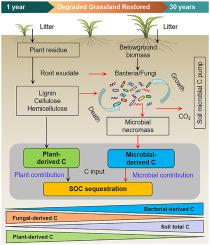Soil Biology and Biochemistry ( IF 9.8 ) Pub Date : 2022-04-28 , DOI: 10.1016/j.soilbio.2022.108688 Yang Yang 1, 2, 3 , Yanxing Dou 4 , Baorong Wang 4 , Yunqiang Wang 1, 2, 3 , Chao Liang 5 , Shaoshan An 4 , Andrey Soromotin 6 , Yakov Kuzyakov 7, 8, 9

|
Grassland restoration across the world increases soil organic carbon (SOC) sequestration which is critical for global C cycling and CO2 removal from the atmosphere. However, the relative importance of plant- and microbially-derived C for SOC is still an open question for temperate grasslands. Here, amino sugars and lignin phenols were used as biomarkers to investigate the relative microbial and plant residue contribution to SOC in a 30-year (1-, 5-, 10-, 15-, 25-, 30-year) restoration chronosequence of temperate grassland. The contribution of microbially-derived C (from 4.9 to 13 g kg−1) to SOC was much greater than that of plant-derived C (from 1.3 to 2.3 g kg−1). At the early stage of restoration (<15 years), grassland soils accumulated more C in the form of plant-derived C. In contrast, grassland soils at the late stage of restoration (>15 years) accumulated more microbially-derived C, and less from plant residues. These findings highlight the dominance of microbial contribution to SOC stabilization compared with plant residues. The contribution of bacteria-derived C to SOC gradually increased from 29% to 50% with progress of grassland restoration, while the contribution of fungal C to SOC decreased from 30% to 21%. Consequently, microbial residue contribution to SOC shifts from fungal and bacterial to mainly bacterial residues during grassland restoration. This shift may be due to the faster bacterial growth and a increasing living biomass during grassland restoration, leading to higher accumulation of bacterial residues. Correlation analysis and random forest models showed that belowground plant biomass, soil pH, and living microbial biomass were the main factors regulating plant-derived C. The microbially-derived C in SOC, however, was dependent on living microbial biomass, soil pH and dissolved organic C. Concluding, grassland restoration increased soil C sequestration primarily by microbial necromass (mainly bacterial necromass), and is affected by abiotic and biotic factors, as well as plant C input.
中文翻译:

草地恢复时间序列中微生物残留对土壤有机碳的贡献增加
世界各地的草原恢复增加了土壤有机碳 (SOC) 封存,这对于全球碳循环和从大气中去除CO 2至关重要。然而,植物和微生物来源的碳对 SOC 的相对重要性对于温带草原仍然是一个悬而未决的问题。在这里,氨基糖和木质素酚被用作生物标志物,以研究 30 年(1 年、5 年、10 年、15 年、25 年、30 年)恢复时间序列中微生物和植物残留对 SOC 的相对贡献。温带草原。微生物来源的碳(从 4.9 到 13 g kg -1)对 SOC 的贡献远大于植物来源的碳(从 1.3 到 2.3 g kg -1 ))。在恢复初期(<15 年),草地土壤以植物源碳的形式积累了更多的碳。相比之下,在恢复后期(>15 年),草地土壤积累了更多的微生物源碳,并且较少来自植物残留物。这些发现强调了与植物残留物相比,微生物对 SOC 稳定的贡献占主导地位。随着草地恢复的进行,细菌源碳对土壤有机碳的贡献从29%逐渐增加到50%,而真菌碳对土壤有机碳的贡献从30%下降到21%。因此,在草地恢复过程中,微生物残留对 SOC 的贡献从真菌和细菌转变为主要是细菌残留。这种转变可能是由于草地恢复过程中细菌生长更快和生物量增加,导致更多的细菌残留物积累。相关分析和随机森林模型表明,地下植物生物量、土壤 pH 值和活微生物量是调节植物源碳的主要因素。然而,SOC 中的微生物源碳依赖于活微生物量、土壤 pH 值和溶解有机碳。结论是,草地恢复主要通过微生物坏死物质(主要是细菌坏死物质)增加土壤碳固存,并受非生物和生物因素以及植物碳输入的影响。











































 京公网安备 11010802027423号
京公网安备 11010802027423号